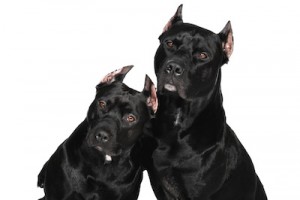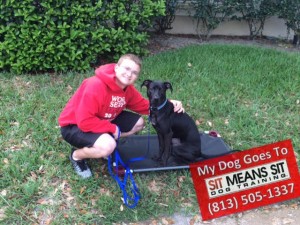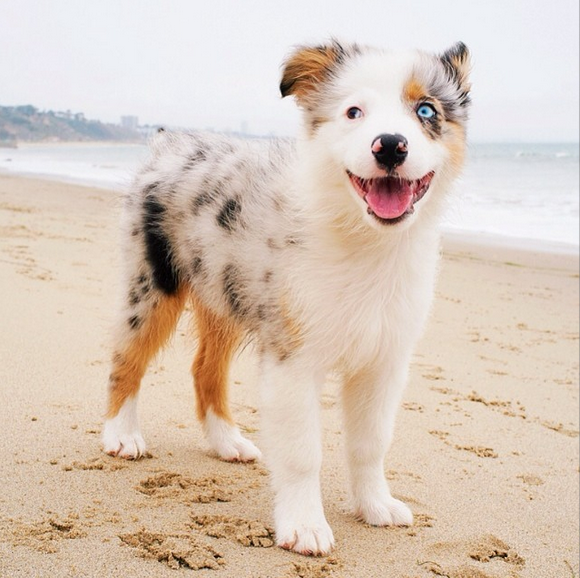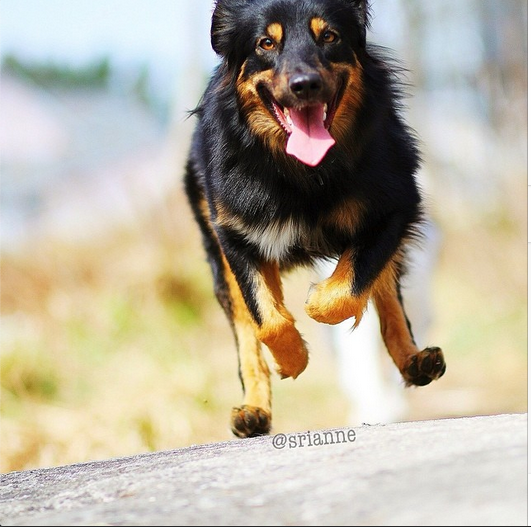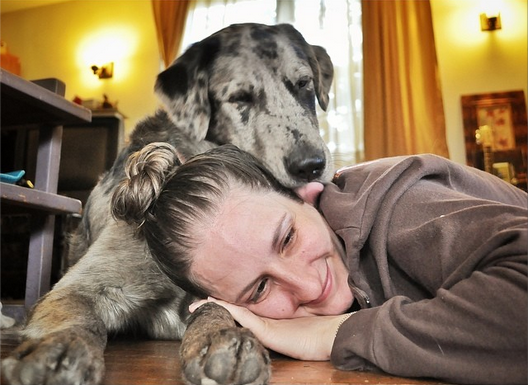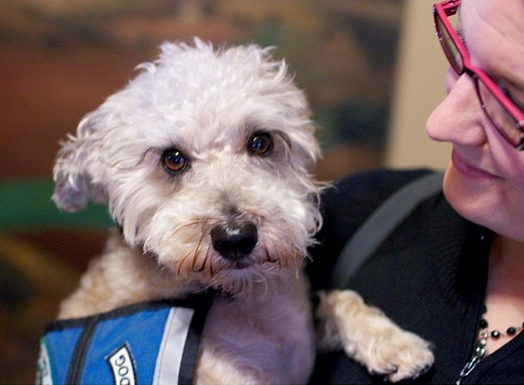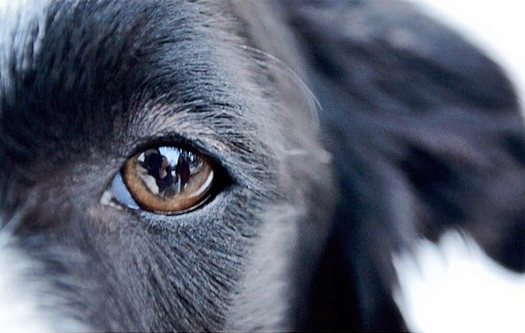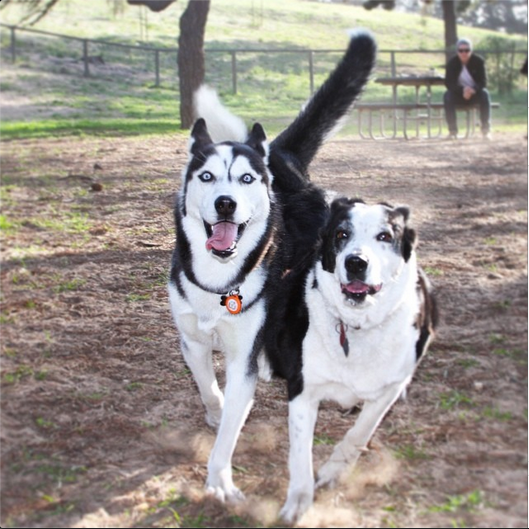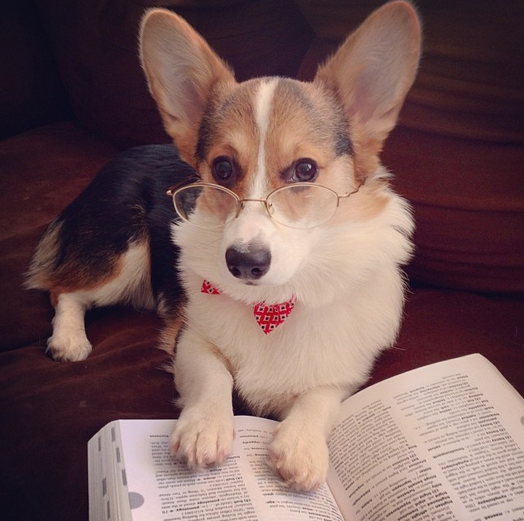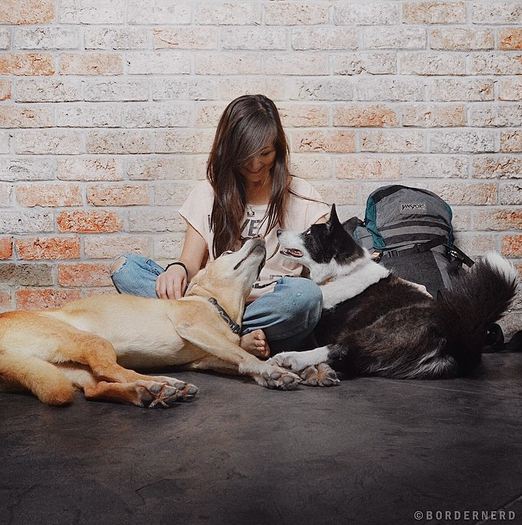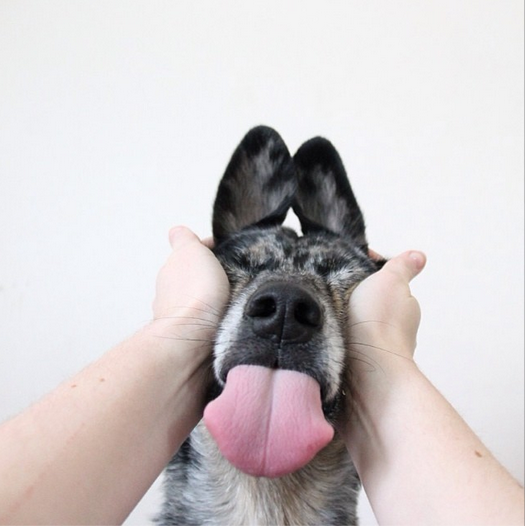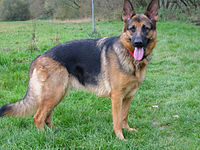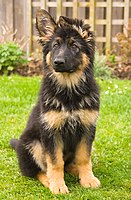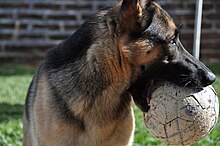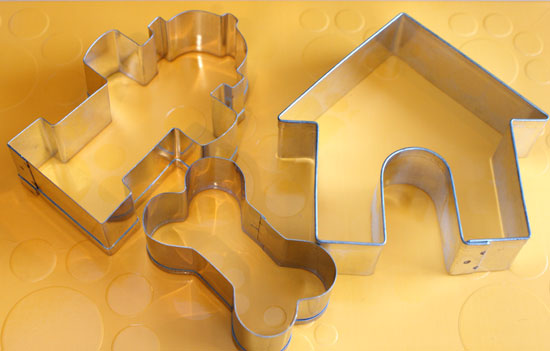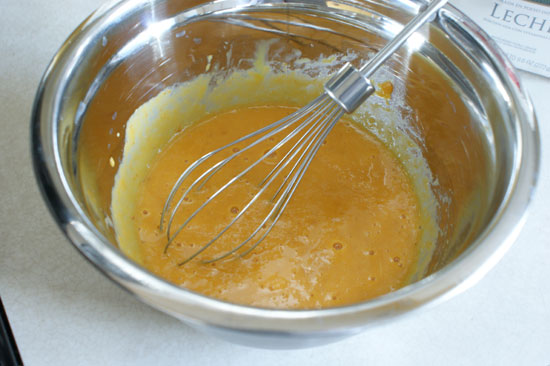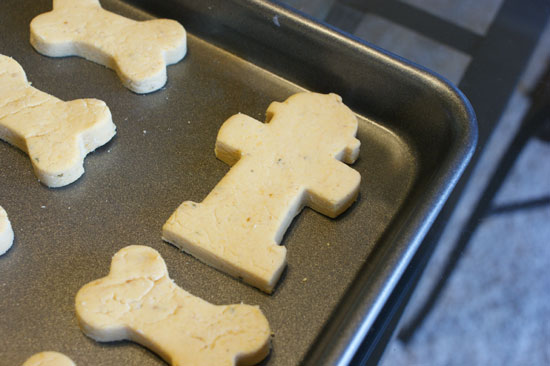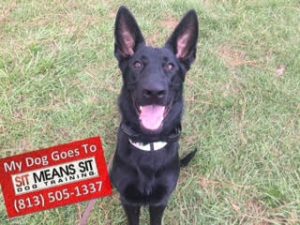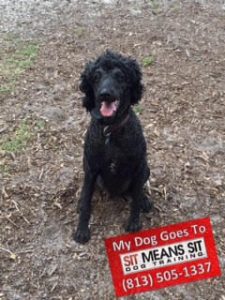German Shepherd Dog
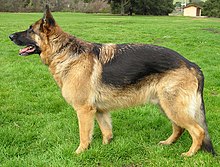 |
| Other names |
Alsatian (UK)
Alsatian wolf dog (UK)
Berger Allemand
Deutscher Schäferhund
Schäferhund |
| Nicknames |
Alsatian, Deutscher Schäferhund, DSH, GSD, Shepherd, Schäferhund |
| Country of origin |
Germany |
| Traits |
| Weight |
Male |
30–40 kg (66–88 lb)[1][2] |
| Female |
22–32 kg (49–71 lb)[1][2] |
| Height |
Male |
60–65 cm (24–26 in)[1][2] |
| Female |
55–60 cm (22–24 in)[1][2] |
| Coat |
Double coat |
| Colour |
Most commonly tan with black saddle |
| Litter size |
4–9[3] |
| Life span |
9–13 years[4] |
|
| [show]Classification / standards |
|
| Dog (Canis lupus familiaris) |
The German Shepherd (German: Deutscher Schäferhund, German pronunciation:[ˈʃɛːfɐˌhʊnt]) is a breed of medium to large-sizedworking dog that originated in Germany. The breed’s officially recognized name is German Shepherd Dog in the English language, sometimes abbreviated as GSD and was also formerly known as the Alsatian in Britain.[5] The German Shepherd is a relatively new breed of dog, with their origin dating to 1899. As part of the Herding Group, German Shepherds are working dogs developed originally for herding sheep. Since that time, however, because of their strength, intelligence, trainability and obedience, German Shepherds around the world are often the preferred breed for many types of work, including disability assistance, search-and-rescue, police and military roles, and even acting.[6] The German Shepherd is the second-most popular breed of dog in the United States[7] and fourth-most popular in the United Kingdom.[8]
Description

German Shepherds have black masks and black body markings.
German Shepherds are medium to large-sized dogs. The breed standard height at thewithers is 60–65 cm (24–26 in) for males and 55–60 cm (22–24 in) for females.[1][9][10] The weight standard is 30–40 kilograms (66–88 lb) for males and 22–32 kilograms (49–71 lb) for females.[1] They have a domed forehead, a long square-cut muzzle and a black nose. The jaws are strong, with a scissor-like bite. The eyes are medium-sized and brown with a lively, intelligent and self-assured look. The ears are large and stand erect, open at the front and parallel, but they often are pulled back during movement. They have a long neck, which is raised when excited and lowered when moving at a fast pace. The tail is bushy and reaches to the hock.[9]
German Shepherds have a variety of colors, the most common of which are tan/black and red/black. Most color varieties have black masks and black body markings which can range from a classic “saddle” to an over-all “blanket.” Rarer colour variations include the sable, pure-black, pure-white, liver and blue varieties. The all-black and sable varieties are acceptable according to most standards; however, the blue and liver are considered to be serious faults and the all-white is grounds for instant disqualification from showing in conformation at All Breed and Specialty Shows.[11]
German Shepherds sport a double coat. The outer coat, which sheds all year round, is close and dense with a thick undercoat. The coat is accepted in two variants; medium and long. The long-hair gene is recessive, making the long-hair variety rarer. Treatment of the long-hair variation differs across standards; they are accepted but not competed with standard coated dogs under the German and UK Kennel Clubs while they can compete with standard coated dogs but are considered a fault in the American Kennel Club.[9][11][12]The FCI accepted the long-haired type in 2010, listing it as the variety b—while short-haired type is listed as the variety a.[13]
-
German Shepherds are medium to large sized dogs.
-
Close-up of a German Shepherd’s face showing the long muzzle, black nose and brown, medium-sized eyes
-
A female German Shepherd with a sable color scheme (note the different colors of the puppies)
-
The adult German Shepherd’s ears are large and stand erect, but 14-week-old puppies’ ears are often not completely erect yet.
-
A solid black German Shepherd
Intelligence

A 7-year-old German shepherd displaying high levels of intelligence when completing an obstacle course for military working dogs at U.S. Army Garrison Stuttgart, Germany
German Shepherds were bred specifically for their intelligence,[14] a trait for which they are now famous.[6] In the book The Intelligence of Dogs, author Stanley Coren ranked the breed third for intelligence, behind Border Collies and Poodles.[15][16] He found that they had the ability to learn simple tasks after only five repetitions and obeyed the first command given 95% of the time.[6] Coupled with their strength, this trait makes the breed desirable as police, guard and search and rescue dogs, as they are able to quickly learn various tasks and interpret instructions better than other large breeds.[17]
Temperament

German Shepherds are well renowned for their protectiveness over family members
German Shepherds are moderate active dogs and described in breed standards as self-assured.[11] The breed is marked by a willingness to learn and an eagerness to have a purpose. They are curious, which makes them excellent guard dogs and suitable for search missions. They can become over-protective of their family and territory, especially if not socialized correctly. They are not inclined to become immediate friends with strangers.[18] German Shepherds are highly intelligent and obedient.[19]
Aggression and biting
Well-trained and socialized German Shepherds have a reputation of being very safe. The Centers for Disease Control and Prevention (CDC) estimates that nearly 4.5 million people in the United States are bitten by dogs each year, but bully breeds are less often to blame than many other breeds, including chow chows and German shepherds.[20] An Australian report from 1999 provides statistics showing that German Shepherds are the breed third most likely to attack a person in some Australian locales.[21]
According to the National Geographic Channel television show Dangerous Encounters, the bite of a German Shepherd has a force of over 1,060 newtons (238 lbf) (compared with that of a Rottweiler, over 1,180–1,460 newtons (265–328 lbf), a Pit bull, 1,050 newtons (235 lbf), a Labrador Retriever, of approximately 1,000 newtons (230 lbf), or a human, of approximately 380 newtons (86 lbf)).[22]
Modern breed
The modern German Shepherd breed is criticized by some for straying away from Max von Stephanitz‘s original ideology that German Shepherds should be bred primarily as working dogs and that breeding should be strictly controlled to eliminate defects quickly.[23][24] He believed that, above all else, German Shepherds should be bred for intelligence and working ability.[25]
Controversy

The show-line dogs usually have an extremely sloping topline
The Kennel Club, in the United Kingdom, is involved in a dispute with German Shepherd breed clubs about the issue of soundness in the show-strain breed.[26][27] The show-strains have been bred with an extremely sloping topline (back) that causes poor gait in the hind legs. Working-pedigree lines, such as those in common use as service dogs, generally retain the traditional straight back of the breed.
The debate was catalyzed when the issue was raised in the BBC documentary, Pedigree Dogs Exposed, which said that critics of the breed describe it as “half dog, half frog”. An orthopedic vet remarked on footage of dogs in a show ring that they were “not normal”.
The Kennel Club’s position is that “this issue of soundness is not a simple difference of opinion, it is the fundamental issue of the breed’s essential conformation and movement.”[26] The Kennel Club has decided to retrain judges to penalize dogs suffering these problems.[28]
It is also insisting on more testing for hemophilia and hip dysplasia, other common problems with the breed.
Use as working dog
German Shepherds are a popular selection for use as working dogs. They are especially well known for their police work, being used for tracking criminals, patrolling troubled areas and detection and holding of suspects. Additionally thousands of German Shepherds have been used by the military. Usually trained for scout duty, they are used to warn soldiers to the presence of enemies or of booby traps or other hazards.[29] German Shepherds have also been trained by military groups to parachute from aircraft[30] or as anti-tank weapons. They were used in World War II as messenger dogs, rescue dogs and personal guard dogs.[25] A number of these dogs were taken home by foreign servicemen, who were impressed by their intelligence.[25]
The German Shepherd is one of the most widely used breeds in a wide variety of scent-work roles. These include search and rescue, cadaver searching, narcotics detection,explosives detection, accelerant detection and mine detection dog, among others. They are suited for these lines of work because of their keen sense of smell and their ability to work regardless of distractions.[29] At one time the German Shepherd was the breed chosen almost exclusively to be used as a guide dog for the visually impaired. When formal guide dog training began in Switzerland in the 1920s under the leadership of Dorothy Eustis, all of the dogs trained were German Shepherd females.[31] An experiment in temperament testing of a group of Labrador Retrievers and German Shepherds showed that the Retrievers scored higher on average in emotional stability and ability to recover promptly from frightening situations, cooperative behavior and friendliness; while the German Shepherds were superior in aggression and defensive behavior. These results suggested that Labrador Retrievers were more suited to guide dog work while German Shepherds were more suited to police work.[32] Currently, Labradors and Golden Retrievers are more widely used for this work, although there are still German Shepherds being trained. In 2013, about 15% of the dogs trained by Guide Dogs of America are German Shepherds, while the remainder are Labrador Retrievers and Golden Retrievers.[33] The Guide Dogs for the Blind Association in the United Kingdom states that crosses between Golden Retrievers and Labrador Retrievers make the best guide dogs, although they also train some German Shepherds, as well as some other breeds.[34] Guide Dogs for the Blind in the United States trains only Labrador Retrievers, Golden Retrievers and crosses between these breeds.[35] Guide Dogs Queensland in Australia also trains only Labrador Retrievers and Golden Retrievers.[36]
German Shepherds are still used for herding and tending sheep grazing in meadows next to gardens and crop fields. They are expected to patrol the boundaries to keep sheep from trespassing and damaging the crops. In Germany and other places these skills are tested in utility dog trials also known as HGH (Herdengebrauchshund) herding utility dog trials.[37]
One Mexican German Shepherd, Zuyaqui, was dissected and his body put on display at the Sedena‘s “Narco Museum” in Mexico. He is regarded to be the dog who has captured the most drugs in Mexican police and military history.[38]
-
A German night-watchman from 1950 with his German Shepherd
-
-
-
A German Shepherd Military Working Dog locates hidden explosives inside a car during a training exercise
History

Illustration of a German Shepherd from 1909
In Europe during the 1850s, attempts were being made to standardize breeds.[39] The dogs were bred to preserve traits that assisted in their job of herding sheep and protecting flocks from predators.[25] In Germany this was practiced within local communities, where shepherds selected and bred dogs. It was recognized that the breed had the necessary skills for herding sheep, such as intelligence, speed, strength and keen senses of smell.[25] The results were dogs that were able to do such things, but that differed significantly, both in appearance and ability, from one locality to another.[39]
To combat these differences, the Phylax Society was formed in 1891 with the intention of creating standardised development plans for native dog breeds in Germany.[25] The society disbanded after only three years due to ongoing internal conflicts regarding the traits in dogs that the society should promote;[25] some members believed dogs should be bred solely for working purposes, while others believed dogs should be bred also for appearance.[40] While unsuccessful in their goal, the Phylax Society had inspired people to pursue standardising dog breeds independently.
With the rise of large, industrialized cities in Germany, the predator population began to decline, rendering sheepdogs unnecessary.[25] At the same time, the awareness of sheepdogs as a versatile, intelligent class of canine began to rise.[25]Max von Stephanitz, an ex-cavalry captain and former student of the Berlin Veterinary College, was an ex-member of the Phylax Society who firmly believed dogs should be bred for working.[25] He admired the intelligence, strength and ability of Germany’s native sheepdogs, but could not find any one single breed that satisfied him as the perfect working dog.[25]

In 1899, Von Stephanitz was attending a dog show when he was shown a dog named
Hektor Linksrhein.
[25] Hektor was the product of few generations of selective breeding and completely fulfilled what Von Stephanitz believed a working dog should be. He was pleased with the strength of the dog and was so taken by the animal’s intelligence, loyalty and beauty, that he purchased him immediately.
[39] After purchasing the dog he changed his name to
Horand von Grafrath and Von Stephanitz founded the
Verein für Deutsche Schäferhunde (Society for the German Shepherd Dog).
[39] Horand was declared to be the first German Shepherd Dog and was the first dog added to the society’s breed register.
[25]
Horand became the centre-point of the breeding programs and was bred with dogs belonging to other society members that displayed desirable traits and with dogs from Thuringia, Franconia and Wurttemberg.[25] Fathering many pups, Horand’s most successful was Hektor von Schwaben.[25][41] Hektor was inbred with another of Horand’s offspring and produced Heinz von Starkenburg, Beowulf and Pilot, who later fathered a total of eighty-four pups, mostly through being inbred with Hektor’s other offspring.[25] This inbreeding was deemed necessary in order to fix the traits being sought in the breed.[25] In the original German Shepherd studbook, Zuchtbuch für Deutsche Schäferhunde (SZ), within the two pages of entries from SZ No. 41 to SZ No. 76, there are four Wolf Crosses.[42] Beowulf’s progeny also were inbred and it is from these pups that all German Shepherds draw a genetic link. It is believed the society accomplished its goal mostly due to Von Stephanitz’s strong, uncompromising leadership and he is therefore credited with being the creator of the German Shepherd Dog.[43]
Etymology

German Shepherd Dogs. Female (left), Male (right).
The breed was named Deutscher Schäferhund by von Stephanitz, literally translating to “German Shepherd Dog”. The breed was so named due to its original purpose of assisting shepherds in herding and protecting sheep. At the time, all other herding dogs in Germany were referred to by this name; they thus became known as Altdeutsche Schäferhunde or Old German Shepherd Dogs.
The direct translation of the name was adopted for use in the official breed registry; however, at the conclusion of World War I, it was believed that the inclusion of the word “German” would harm the breed’s popularity,[44] due to the anti-German sentiment of the era.[45]The breed was officially renamed by the UK Kennel Club to “Alsatian Wolf Dog”,[44] after the French-German border area of Alsace-Lorraine.[25] This name was also adopted by many other international kennel clubs.
Eventually, the appendage “wolf dog” was dropped,[44] after numerous campaigns by breeders who were worried that becoming known as a wolf-dog hybrid would affect the breed’s popularity and legality.[25] The name Alsatian remained for five decades,[44] until 1977, when successful campaigns by dog enthusiasts pressured the British kennel clubs to allow the breed to be registered again as German Shepherds.[5] The word “Alsatian” still appeared in parentheses as part of the formal breed name and was only removed in 2010.[46]
Popularity

German Shepherd
When the UK Kennel accepted registrations in 1919, 54 German Shepherds were registered. By 1926 this number had grown to over 8,000.[39] The breed gained international recognition after the decline of World War I. Returning soldiers spoke highly of the breed and animal actors Rin Tin Tin and Strongheart popularised the breed further.[47] The first German Shepherd Dog registered in the United States was Queen of Switzerland. Her offspring suffered from defects as the result of poor breeding, which caused the breed to suffer a decline in popularity during the late 1920s.[47]
Popularity increased again after the German Shepherd Sieger Pfeffer von Bern became the 1937 and 1938 Grand Victor in American Kennel club dog shows, only to suffer another decline at the conclusion of World War II, due to anti-German sentiment.[47] Popularity increased gradually until 1993, when they became the third most popular breed in the United States. As of 2012, the German Shepherd is the second most popular in the US.[47][48] Additionally, the breed is typically among the most popular in other registries.[47] The German Shepherd Dog’s physique is very well suited to athletic competition, competing in shows and competitions such as agility trials.
Health

A 9-week-old German Shepherd puppy
Many common ailments of the German Shepherds are a result of the inbreeding practiced early in the breed’s life (although this was necessary to preserve other traits for the breed).[49] One such common ailment is hip and elbow dysplasia which may lead to the dog experiencing pain in later life and may cause arthritis.[50] A study conducted by the University of Zurich found that 45% of the police working dogs were affected by degenerative spinal stenosis, although the sample studied was small.[51] The Orthopedic Foundation for Animals found that 19.1% of German Shepherd are affected by hip dysplasia.[52] Due to the large and open nature of their ears, German Shepherds are not prone to ear infections because there is no hair in the outer ear canal to hold debris or moisture.[53] According to a recent survey in the UK, the median life span of German Shepherds is 10.95 years,[4] which is normal for a dog of their size.
Degenerative myelopathy, a neurological disease, occurs with enough regularity specifically in the breed to suggest that the breed is predisposed to it. A very inexpensive DNA saliva test is now available to screen for Degenerative Myelopathy. The test screens for the mutated gene that has been seen in dogs with degenerative myelopathy. A small study in the UK showed 16% of young asymptomatic GSDs to be homozygous for the mutation, with a further 38% being carriers.[54] Now that a test is available the disease can be bred out of breeds with a high preponderance. The test is only recommended for predisposed breeds, but can be performed on DNA from any dog on samples collected through swabbing the inside of the animal’s cheek with a sterile cotton swab. Now that there is a test available, prospective German Shepherd buyers can request the test from the breeder or buy from a breeder known to test their dogs.[55]
Additionally, German Shepherds have a higher than normal incidence of Von Willebrand disease, a common inherited bleeding disorder.[56]Exocrine pancreatic insufficiency (EPI), a degenerative disease of the pancreas. It is estimated that 1% of the UK GSD population suffers from this disease.[57] Treatment is usually in the form of pancreatic supplements being given with food.
In popular culture
German Shepherds have been featured in a wide range of media.[58] In 1921 Strongheart became one of the earliest canine film stars, and was followed in 1922 by Rin Tin Tin, who is considered the most famous German Shepherd. Both have stars on the Hollywood Walk of Fame.[59] German Shepherds were used in the popular Canadian series The Littlest Hobo. Batman‘s dog Ace the Bat-Hound appeared in theBatman comic books, initially in 1955,[60] through 1964.[61] Between 1964 and 2007, his appearances were sporadic. A German Shepherd calledInspector Rex, is the star of Austrian Police procedural drama program, which won many awards, where German Shepherd Rex assists the Vienna Kriminalpolizei homicide unit.[62] The show was aired in many languages.[63
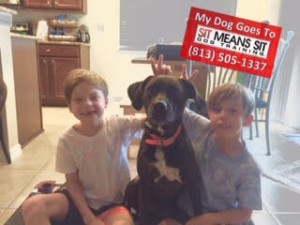 Phineas was cute a sweet but hyper dog. After a week of Board and Train,he is much calmer, listens better and is a joy to walk. Even in a household with 7 year twin boys he keeps his cool and listens to commands. He has been practicing his training with various friends and family to be sure he remembers to listen to everyone. So proud of his progress and so grateful to Megan for her help! Also must mention that we had family issues going on and Rachel was a huge help in working with us with scheduling to assure Phineas had the best possible experience.
Phineas was cute a sweet but hyper dog. After a week of Board and Train,he is much calmer, listens better and is a joy to walk. Even in a household with 7 year twin boys he keeps his cool and listens to commands. He has been practicing his training with various friends and family to be sure he remembers to listen to everyone. So proud of his progress and so grateful to Megan for her help! Also must mention that we had family issues going on and Rachel was a huge help in working with us with scheduling to assure Phineas had the best possible experience.
